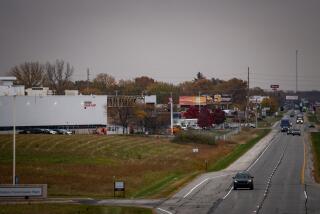Domestic automakers gain traction in California
Ian Goodwin has always preferred import cars — until now.
His family’s fleet includes a Volkswagen, a Volvo and a Hyundai. Yet when it came time to replace his sporty Subaru Impreza WRX with a car more suited to his 17-year-old son, Goodwin picked out a Ford Fiesta.
“Ford seems to have brought its act up in the last couple of years,” said Goodwin, 46, a business analyst from the Oak Park neighborhood of Ventura County. “This was the first Ford I have ever owned.”
More California buyers are making a similar shift, giving domestic automakers the kind of boost they haven’t seen in years. California is the nation’s largest and trendiest car market but has been one of the worst for American brands.
They are gaining ground mostly because they have come out with a new generation of small cars and compact SUVs that are competitive with the Hondas and Toyotas that have long dominated the market, said George Peterson, president of AutoPacific Inc., a Tustin automotive industry consulting firm.
“Historically all of the domestics have had a real challenge selling in California,” Peterson said.
A year ago, Chevrolet was essentially a non-player when it came to small-car sales in the state. Its Cobalt subcompact accounted for a barely measurable 1.1% of sales to California consumers — the crucial retail part of the business that factors out fleet buyers such as car rental companies and governmental agencies. It’s replacement, the Cruze, has soared to 3.3% of the subcompact market in the first quarter of this year.
While that’s still small compared with the dominance of the market leading Honda Civic, which accounts for 1 of every 5 compact car sales in the state, Chevrolet is capturing a growing slice of sales as more people learn about the Cruze, according to auto analysts.
It captured the attention of buyers such as Karen Peters, a hospital worker from San Jacinto, who traded in her 2005 Toyota Corolla for a Cruze in January.
“The car looks sharp. I test-drove one and checked it out and bought it,” Peters said.
Peters, 61, said she likes the fuel economy. Her Cruze gets about 34 miles per gallon in a combination of city and highway driving compared with the 29 mpg of her Corolla. Peters, who works late at night, also found the OnStar vehicle diagnostic and communications system “a comfort” because it automatically calls for help in the event of a crash.
Electronics and so-called infotainment systems such as OnStar and Ford’s Sync are giving domestic brands a sales advantage over their Japanese rivals, Peterson said.
Chevrolet had 8.3% of retail auto sales in California during the first quarter of this year, according to the California New Car Dealers Assn. That’s up from 7.4% in the same period a year earlier and is its highest level since 2007, when sales were powered by large trucks and SUVs rather than the small cars and crossovers the company sells more of now.
“The growth in California is extremely important to us,” said Alan Batey, vice president of sales and service for Chevrolet.
The Chevrolet Camaro is California’s top selling “sporty compact,” with about a third of the market, according to the dealers trade group. Its Equinox compact SUV has climbed to third in that segment’s ranking, trailing the Honda CR-V and Toyota RAV4.
Chrysler, which has just started to launch a series of new vehicles since emerging from bankruptcy in 2009, is only beginning to gain traction in California. Including its Dodge and Jeep brands, Chrysler had 5.9% of the California market in the first quarter, unchanged from a year ago.
Toyota is still the top player with 18.5% of the California retail market, but that’s been inching down. The share of the California market controlled by Japanese automakers fell almost a full percentage point to 49.1% in the first quarter compared with the same period a year earlier, according to the auto dealers group.
Helped by a trio of sedans, the Fiesta, Focus and Fusion, Ford is also making large gains. Its retail sales in California jumped 37% from January through April over the same four months last year, compared with a 25% gain nationally over the same period.
“Clearly, this market is a litmus test for Ford’s ability to grow our business by connecting with small car customers,” Ken Czubay, the company’s vice president U.S. sales and marketing.
To win in California, an automaker has to offer competitive fuel efficiency because of the way high gas prices in the region influence sales, Czubay said. Ford says it has learned that lesson and is applying it to even its large vehicles. Later this year, Ford is coming out with a turbocharged four-cylinder version of its Explorer SUV, which already sells well in California in a six-cylinder version. And Ford is seeing sales of its six-cylinder F-150 pickup truck outpace its V8 offering.
Ford’s share of the California market grew to 11.6% in the first quarter, compared with 11.3% in the same period a year earlier, the dealers group said. Ford says that’s the highest level since 2002. The Dearborn automaker narrowly trailed second place Honda in the first quarter and could jump ahead now, because of the quake-related production and supply problems hampering sales of some Japanese-branded autos.
This is good news to auto dealers such as Ron Davis, owner of Santa Monica Ford, who said sales last month were 67% above May 2010.
“We are drawing from a bigger base of customers than we used to, especially younger people, who historically in Southern California have tended to be import buyers,” he said.
Peterson said he believes the California market is undergoing a generational shift in which domestic automakers are having success selling competitive passenger cars and crossovers rather than relying on the large trucks and SUVs of previous sales upswings.
“Each time they bring out a new generation car they only get stronger,” he said.







